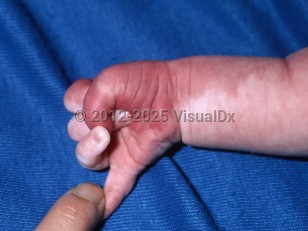Sturge-Weber syndrome in Infant/Neonate
See also in: External and Internal EyeAlerts and Notices
Important News & Links
Synopsis

Sturge-Weber syndrome (SWS) is a noninherited congenital condition characterized by an extensive port-wine stain involving the V1 area (most frequently), eye abnormalities, and leptomeningeal and other brain abnormalities. In SWS, all 3 organ systems can be involved or a combination of systems. Glaucoma, often in the neonatal period, is a frequent association in up to 30% of patients with the syndrome. A number of neurological problems are associated and include epilepsy (which often has its onset in infancy or early childhood and is seen in a majority of patients with SWS), intellectual disability, hemiplegia, hemiatrophy, microencephaly, cortical blindness, increased intracranial pressure, and intracranial hemorrhage. Approximately 90% of patients have an activating somatic mutation in GNAQ, which encodes a G-protein subunit, in the affected tissues.
Codes
ICD10CM:
Q85.89 – Other phakomatoses, not elsewhere classified
SNOMEDCT:
19886006 – Sturge-Weber syndrome
Q85.89 – Other phakomatoses, not elsewhere classified
SNOMEDCT:
19886006 – Sturge-Weber syndrome
Look For
Subscription Required
Diagnostic Pearls
Subscription Required
Differential Diagnosis & Pitfalls

To perform a comparison, select diagnoses from the classic differential
Subscription Required
Best Tests
Subscription Required
Management Pearls
Subscription Required
Therapy
Subscription Required
References
Subscription Required
Last Updated:01/24/2022
Sturge-Weber syndrome in Infant/Neonate
See also in: External and Internal Eye
